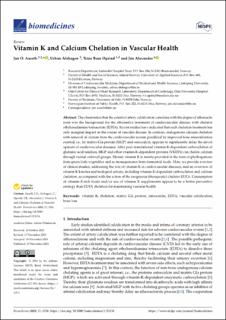Vitamin K and Calcium Chelation in Vascular Health
Peer reviewed, Journal article
Published version
Permanent lenke
https://hdl.handle.net/11250/3117504Utgivelsesdato
2023Metadata
Vis full innførselSamlinger
Sammendrag
The observation that the extent of artery calcification correlates with the degree of atherosclerosis was the background for the alternative treatment of cardiovascular disease with chelator ethylenediamine tetraacetate (EDTA). Recent studies have indicated that such chelation treatment has only marginal impact on the course of vascular disease. In contrast, endogenous calcium chelation with removal of calcium from the cardiovascular system paralleled by improved bone mineralization exerted, i.e., by matrix Gla protein (MGP) and osteocalcin, appears to significantly delay the development of cardiovascular diseases. After post-translational vitamin-K-dependent carboxylation of glutamic acid residues, MGP and other vitamin-K-dependent proteins (VKDPs) can chelate calcium through vicinal carboxyl groups. Dietary vitamin K is mainly provided in the form of phylloquinone from green leafy vegetables and as menaquinones from fermented foods. Here, we provide a review of clinical studies, addressing the role of vitamin K in cardiovascular diseases, and an overview of vitamin K kinetics and biological actions, including vitamin-K-dependent carboxylation and calcium chelation, as compared with the action of the exogenous (therapeutic) chelator EDTA. Consumption of vitamin-K-rich foods and/or use of vitamin K supplements appear to be a better preventive strategy than EDTA chelation for maintaining vascular health.

